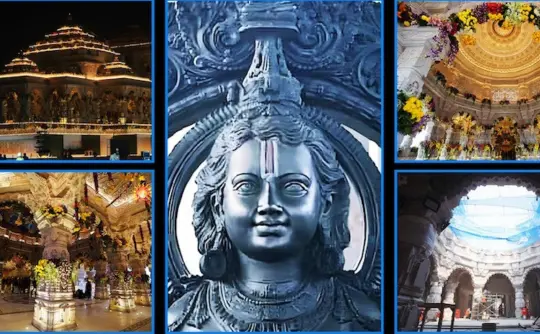Blogs
Ram Mandir
In the heart of Ayodhya, a city that echoes the ancient tales of the Ramayana, stands the magnificent Ayodhya Ram Temple. The Ayodhya Ram Mandir stands as a symbol deeply rooted in the rich faith and culture. As you embark on a journey through the history and significance of this Ayodhya heritage site, you’ll discover its profound impact on India’s spiritual and cultural landscape.
Ayodhya Ram Temple: A Symbol Of Faith And Cultural Heritage

The Historical Significance Of Ayodhya Ram Temple
Ayodhya is believed to be the birthplace of Lord Rama. It holds immense significance for millions of devotees. The ancient city witnessed the unfolding of the epic Ramayana, a timeless narrative that transcends generations. As you stand before the Ayodhya Ram Temple, you can’t help but feel the echoes of the past as the bricks and stones seem to whisper the age-old stories of devotion and righteousness. Ayodhya is one of the top holy sites in India. It is known for some of the most famous Ayodhya temples that attract tourists from all across the country.
Ayodhya Ram Temple: The Birthplace Of Lord Rama
At the heart of the temple’s significance lies the belief that it stands on the spot where Lord Rama, the seventh avatar of Lord Vishnu, was born. The Ayodhya Ram Mandir becomes not just a structure but a sacred ground, revered by devotees who see it as a living connection to their beloved deity. It’s a place where faith comes alive, bridging the gap between the mortal and the divine.
Shree Ram Mandir Ayodhya: The Long-Standing Quest For A Temple
The journey of the Ayodhya Ram Temple has not been without its share of trials and tribulations. The historic and legal battles surrounding the site have been etched into the national consciousness. Over the years, the Ayodhya Ram Temple faced challenges and controversies, but the faith of the devotees kept the flame of hope alive. As you explore the Shree Ram Mandir Ayodhya site, you witness the resilience of faith over adversities.
Architectural Splendour
The Ayodhya Ram Temple is not just a testament to faith; it is also a masterpiece of architectural brilliance. The temple’s design seamlessly blends traditional and modern elements, reflecting the cultural diversity that defines India. The towering spires, intricate carvings, and the majestic sanctum sanctorum all create an awe-inspiring ambience. As you gaze upon the Shree Ram Mandir Ayodhya temple, you can’t help but marvel at the craftsmanship that has gone into making it a visual symphony of devotion.
Symbol Of Unity
The Shree Ram Mandir Ayodhya Temple serves as a unifying force, bringing together people from diverse backgrounds. The Ayodhya Ram Mandir’s construction symbolises national unity, transcending religious and regional divides. It stands as a testament to the inclusivity of Indian culture, where diversity is celebrated and unity is forged through shared values and beliefs.
Cultural Preservation
The Ayodhya Ram Temple not only symbolises faith but also serves as a guardian of India’s cultural legacy. The art, architecture, and rituals associated with the temple are treasures that connect the present with the past. As you witness the cultural richness embedded in every corner of the temple, you become a part of the legacy.
Spiritual Pilgrimage
One of the most famous temples in Ayodhya, the Ram Temple is more than a physical journey; it’s a spiritual pilgrimage. The temple becomes a sacred space where individuals seek solace, guidance, and a deeper connection with the divine. The rituals, prayers, and the sacred atmosphere create an environment allowing devotees to experience a sense of peace and spiritual fulfilment.


